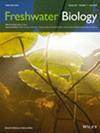Testing Environmental Filters Across Basins: Community Assembly of Freshwater Fishes in a Subtropical Montane Riverscape
IF 2.7
2区 生物学
Q2 ECOLOGY
引用次数: 0
Abstract
- Freshwater fish communities differ widely across spatial scales due to environmental filtering and limited dispersal. However, the relative importance of these mechanisms is poorly understood, especially along subtropical elevational gradients. Species traits may further help to predict species niches and co-occurrences and allow for generalisations across multiple ecosystems. We aimed to model the occurrence of fish species as a function of environmental covariates and distance, testing for the effects of traits and phylogeny on species niches and co-occurrence patterns. We also aimed to test the consistency in these relationships between the river basins.
- We fitted two joint species distribution models (JSDM) to a dataset of fish sampled over multiple years, across the Teesta–Jaldhaka basins of the Eastern Himalayas.
- The effects of environmental filtering were stronger than those of distance. Elevation, total dissolved solutes, dissolved oxygen and stream width explained much variation in species occurrences, but their relative importance differed among basins. Traits explained relatively less variation in species niches and co-occurrences, and their effects differed among basins. However, the residual phylogenetic signal in niches indicates that unmeasured traits likely play a stronger role.
- Environmental filtering primarily structures lotic fish communities along subtropical elevational gradients in the two adjacent Eastern Himalayan River basins. However, the relative influence of covariates and the nature of trait–niche relationships differs.
- This variability makes broad generalisations difficult across freshwater basins while providing an opportunity to test and explore the applicability of ecological filters in other riverine systems.
测试跨流域的环境过滤器:亚热带山地河流景观中淡水鱼的群落组装
由于环境过滤和有限的扩散,淡水鱼群落在空间尺度上差异很大。然而,人们对这些机制的相对重要性知之甚少,特别是在亚热带海拔梯度上。物种特征可以进一步帮助预测物种生态位和共生现象,并允许在多个生态系统中进行推广。我们的目标是模拟鱼类物种的发生作为环境协变量和距离的函数,测试性状和系统发育对物种生态位和共现模式的影响。我们还旨在测试河流流域之间这些关系的一致性。我们将两种联合物种分布模型(JSDM)拟合到喜马拉雅东部testa - jaldhaka盆地多年来采集的鱼类数据集上。环境的过滤作用强于距离的过滤作用。海拔高度、总溶解溶质、溶解氧和河流宽度解释了物种分布的变化,但它们的相对重要性在不同流域有所不同。性状对物种生态位和共现现象的解释相对较小,其作用在不同流域之间存在差异。然而,生态位中残留的系统发育信号表明,未测量的性状可能发挥更大的作用。环境过滤主要是沿亚热带海拔梯度在两个相邻的东喜马拉雅河流域构造的鱼类群落。然而,协变量的相对影响和性状-生态位关系的性质是不同的。这种可变性使得在淡水流域中进行广泛的概括变得困难,同时为测试和探索生态过滤器在其他河流系统中的适用性提供了机会。
本文章由计算机程序翻译,如有差异,请以英文原文为准。
求助全文
约1分钟内获得全文
求助全文
来源期刊

Freshwater Biology
生物-海洋与淡水生物学
CiteScore
5.90
自引率
3.70%
发文量
162
审稿时长
2 months
期刊介绍:
Freshwater Biology publishes papers on all aspects of the ecology of inland waters, including rivers and lakes, ground waters, flood plains and other freshwater wetlands. We include studies of micro-organisms, algae, macrophytes, invertebrates, fish and other vertebrates, as well as those concerning whole systems and related physical and chemical aspects of the environment, provided that they have clear biological relevance.
Studies may focus at any level in the ecological hierarchy from physiological ecology and animal behaviour, through population dynamics and evolutionary genetics, to community interactions, biogeography and ecosystem functioning. They may also be at any scale: from microhabitat to landscape, and continental to global. Preference is given to research, whether meta-analytical, experimental, theoretical or descriptive, highlighting causal (ecological) mechanisms from which clearly stated hypotheses are derived. Manuscripts with an experimental or conceptual flavour are particularly welcome, as are those or which integrate laboratory and field work, and studies from less well researched areas of the world. Priority is given to submissions that are likely to interest a wide range of readers.
We encourage submission of papers well grounded in ecological theory that deal with issues related to the conservation and management of inland waters. Papers interpreting fundamental research in a way that makes clear its applied, strategic or socio-economic relevance are also welcome.
Review articles (FRESHWATER BIOLOGY REVIEWS) and discussion papers (OPINION) are also invited: these enable authors to publish high-quality material outside the constraints of standard research papers.
 求助内容:
求助内容: 应助结果提醒方式:
应助结果提醒方式:


